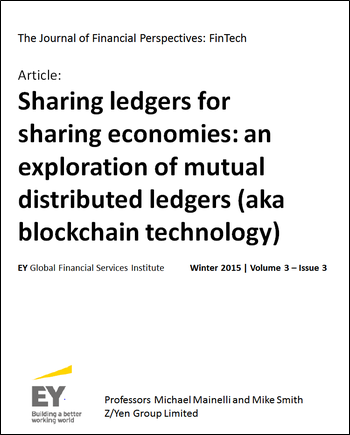Authors
Professor Michael Mainelli & Professor Mike Smith
Published by
Journal of Financial Perspectives, Volume 3, Number 3, EY Global Financial Services Institute (December 2015), 44 pages.
Share on social media:
You might also be interested in:
Sharing Ledgers For Sharing Economies: An Exploration Of Mutual Distributed Ledgers (aka Blockchain Technology)
Mutual distributed ledgers (MDLs) have the potential to transform the way people and organizations handle identity, transaction and debt information. MDL technology provides an electronic public transaction record of integrity without central ownership. The ability to have a globally available, verifiable and untamperable source of data provides anyone wishing to provide trusted third party services, i.e., most financial services firms, the ability to do so cheaply and robustly. Blockchain technology is a form of MDL.
The InterChainZ project was a consortium research project to share learning on MDLs during the summer of 2015. The study found that InterChainZ showcased several distributed ledger configurations and numerous variants, exploring how they might work in a set of agreed “use cases.” The outputs were a series of functioning, interlinked MDLs along with software, explanatory materials and website information. The research consortium concluded that MDLs incorporating trusted third parties for some functions had significant potential in financial services, such as know-your-customer (KYC), antimoney-laundering (AML), insurance, credit and wholesale financial services.




